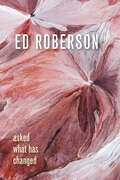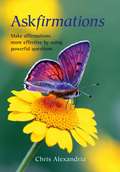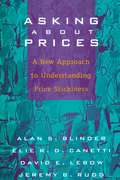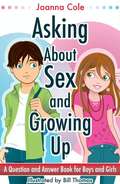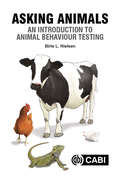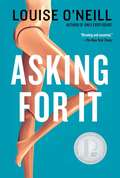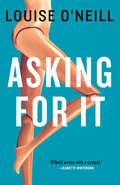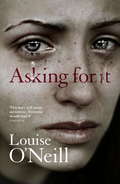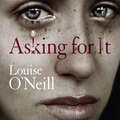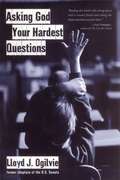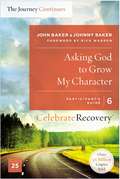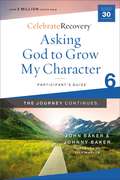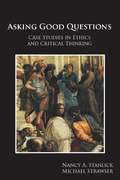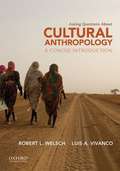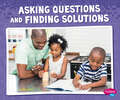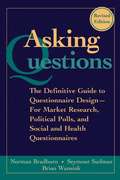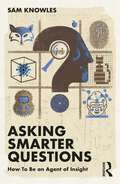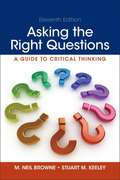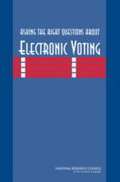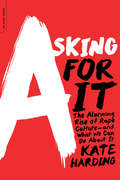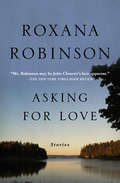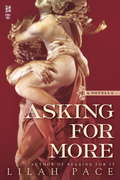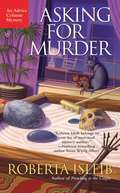- Table View
- List View
Asked What Has Changed (Wesleyan Poetry Series)
by Ed RobersonA Black ecopoet observes the changing world from a high-rise window, &“ever alert to affinities between the small and the vast, the fleeting and the cosmic&” (James Gibbons, Hyperallergic). Award-winning poet Ed Roberson confronts the realities of an era in which the fate of humanity and the very survival of our planet are uncertain. Departing from the traditional nature poem, Roberson's work reclaims a much older tradition, drawing into poetry&’s orbit what the physical and human sciences reveal about the state of a changing world. These poems test how far the lyric can go as an answer to our crisis, even calling into question poetic form itself. Reflections on the natural world and moments of personal interiority are interwoven with images of urbanscapes, environmental crises, and political instabilities. These poems speak life and truth to modernity in all its complexity. Throughout, Roberson takes up the ancient spiritual concern—the ephemerality of life—and gives us a new language to process the feeling of living in a century on the brink.
Askfirmations: Make affirmations more effective by using powerful questions
by Chris AlexandriaHave you ever heard that little skeptical voice piping up in your head when you are trying to think positively? It is in everyone's head, this is called the mind or the ego. Chris Alexandria has discovered a technique for "tricking" the mind, and she explains with great humor how she learned to do this, what she discovered, and how it can make a difference for anyone. Attracting positive things with ease, Chris shares the simple but effective practical exercises that have worked for her.
Asking About Prices: A New Approach to Understanding Price Stickiness
by Alan Blinder David E. Lebow Elie R.D. Canetti Jeremy B. RuddWhy do consumer prices and wages adjust so slowly to changes in market conditions? The rigidity or stickiness of price setting in business is central to Keynesian economic theory and a key to understanding how monetary policy works, yet economists have made little headway in determining why it occurs. Asking About Prices offers a groundbreaking empirical approach to a puzzle for which theories abound but facts are scarce. Leading economist Alan Blinder, along with co-authors Elie Canetti, David Lebow, and Jeremy B. Rudd, interviewed a national, multi-industry sample of 200 CEOs, company heads, and other corporate price setters to test the validity of twelve prominent theories of price stickiness. Using everyday language and pertinent scenarios, the carefully designed survey asked decisionmakers how prominently these theoretical concerns entered into their own attitudes and thought processes. Do businesses tend to view the costs of changing prices as prohibitive? Do they worry that lower prices will be equated with poorer quality goods? Are firms more likely to try alternate strategies to changing prices, such as warehousing excess inventory or improving their quality of service? To what extent are prices held in place by contractual agreements, or by invisible handshakes? Asking About Prices offers a gold mine of previously unavailable information. It affirms the widespread presence of price stickiness in American industry, and offers the only available guide to such business details as what fraction of goods are sold by fixed price contract, how often transactions involve repeat customers, and how and when firms review their prices. Some results are surprising: contrary to popular wisdom, prices do not increase more easily than they decrease, and firms do not appear to practice anticipatory pricing, even when they can foresee cost increases. Asking About Prices also offers a chapter-by-chapter review of the survey findings for each of the twelve theories of price stickiness. The authors determine which theories are most popular with actual price setters, how practices vary within different business sectors, across firms of different sizes, and so on. They also direct economists' attention toward a rationale for price stickiness that does not stem from conventional theory, namely a strong reluctance by firms to antagonize or inconvenience their customers. By illuminating how company executives actually think about price setting, Asking About Prices provides an elegant model of a valuable new approach to conducting economic research.
Asking About Sex & Growing Up
by Joanna Cole Bill ThomasWhat do you want to know about sex? Information about sex is everywhere. But what you learn from TV, movies, the internet, and friends is not always a healthy or accurate view of sexuality. Now revised and updated with current facts, Joanna Cole's Asking About Sex & Growing Up is the perfect book to provide answers to questions about sex. Writing especially for preteens, the author uses a question-and-answer format to offer straightforward information on a wide variety of subjects related to sex and puberty.
Asking Animals: An Introduction to Animal Behaviour Testing
by Birte L. NielsenContemporary, thought-provoking yet utterly practical, this book provides an introductory text covering the use and misuse of behaviour tests applied to animals. By including illustrative examples from a variety of species, the book inspires the animal scientist to think about what a given behavioural test can be used for and how the results can be interpreted. This text includes: the dos and don'ts of running behaviour tests and interpreting the results; many clear, simple illustrations which make the information readily accessible, down to earth, practical advice yet a thorough, evidence-based approach; information on behaviour tests for a whole range of species from companion, farm, zoo, laboratory and wild animals; succinct yet comprehensive text, designed to be read cover to cover and stimulate further reading. This book is an essential item in the researcher's toolkit when embarking on and devising any animal behaviour test and is valuable to students, established researchers, teachers and practitioners of applied ethology, animal welfare science, and veterinary science.
Asking For It
by Louise O'NeillEmma O'Donovan is eighteen, beautiful, and fearless. It's the beginning of summer in a quiet Irish town and tonight she and her friends have dressed to impress. Everyone is at the party, and all eyes are on Emma. The next morning Emma's parents discover her collapsed on the doorstop of their home, unconscious. She is disheveled, bleeding, and disoriented, looking as if she had been dumped there. To her distress, Emma can't remember what happened the night before. All she knows is that none of her friends will respond to her texts. At school, people turn away from her and whisper under their breath. Her mind may be a blank as far as the events of the previous evening, but someone has posted photos of it on Facebook under a fake account, "Easy Emma"--photos she will never be able to forget. As the photos go viral and a criminal investigation is launched, the community is thrown into tumult. The media descends, neighbors chose sides, and people from all over the world want to talk about her story. Everyone has something to say about Emma. Asking For It is a powerful story about the devastating effects of rape and public shaming, told through the awful experience of a young woman whose life is changed forever by an act of violence.
Asking For It
by Louise O'NeillEmma O'Donovan is eighteen, beautiful, and fearless. It's the beginning of summer in a quiet Irish town and tonight she and her friends have dressed to impress. Everyone is at the party, and all eyes are on Emma. The next morning Emma's parents discover her collapsed on the doorstop of their home, unconscious. She is disheveled, bleeding, and disoriented, looking as if she had been dumped there.To her distress, Emma can't remember what happened the night before. All she knows is that none of her friends will respond to her texts. At school, people turn away from her and whisper under their breath. Her mind may be a blank as far as the events of the previous evening, but someone has posted photos of it on Facebook under a fake account, "Easy Emma"--photos she will never be able to forget.As the photos go viral and a criminal investigation is launched, the community is thrown into tumult. The media descends, neighbors chose sides, and people from all over the world want to talk about her story. Everyone has something to say about Emma. Asking For It is a powerful story about the devastating effects of rape and public shaming, told through the awful experience of a young woman whose life is changed forever by an act of violence.
Asking For It
by Louise O'Neill'A soul-shattering novel that will leave your emotions raw. This story will haunt me forever. Everyone should read it' Guardian In a small town where everyone knows everyone, Emma O'Donovan is different. She is the special one - beautiful, popular, powerful. And she works hard to keep it that way. Until that night . . . Now, she's an embarrassment. Now, she's just a slut. Now, she is nothing.And those pictures - those pictures that everyone has seen - mean she can never forget. For fans of Caitlin Moran, Marian Keyes and Jodi Picoult. BOOK OF THE YEAR AT THE IRISH BOOK AWARDS 2015. The award-winning, bestselling novel about the life-shattering impact of sexual assault, rape and how victims are treated.
Asking For It
by Louise O'Neill'A soul-shattering novel that will leave your emotions raw. This story will haunt me forever. Everyone should read it' Guardian In a small town where everyone knows everyone, Emma O'Donovan is different. She is the special one - beautiful, popular, powerful. And she works hard to keep it that way. Until that night . . . Now, she's an embarrassment. Now, she's just a slut. Now, she is nothing.And those pictures - those pictures that everyone has seen - mean she can never forget. For fans of Caitlin Moran, Marian Keyes and Jodi Picoult. BOOK OF THE YEAR AT THE IRISH BOOK AWARDS 2015. The award-winning, bestselling novel about the life-shattering impact of sexual assault, rape and how victims are treated.
Asking For It: the haunting novel from a celebrated voice in feminist fiction
by Louise O'Neill'A soul-shattering novel that will leave your emotions raw. This story will haunt me forever. Everyone should read it' Guardian In a small town where everyone knows everyone, Emma O'Donovan is different. She is the special one - beautiful, popular, powerful. And she works hard to keep it that way. Until that night . . . Now, she's an embarrassment. Now, she's just a slut. Now, she is nothing.And those pictures - those pictures that everyone has seen - mean she can never forget. For fans of Caitlin Moran, Marian Keyes and Jodi Picoult. BOOK OF THE YEAR AT THE IRISH BOOK AWARDS 2015. The award-winning, bestselling novel about the life-shattering impact of sexual assault, rape and how victims are treated. (P)2017 WF Howes Ltd
Asking God Your Hardest Questions
by Lloyd John OgilvieWith warmth and clarity, the now-retired chaplain for the United States Senate offers thoughtful, biblical insights to modern questions.
Asking God to Grow My Character: A Recovery Program Based on Eight Principles from the Beatitudes
by John Baker Johnny BakerA Program for Implementing a Christ-Centered Recovery Ministry in Your Church Alcoholism - Divorce - Sexual Abuse - Codependency - Domestic Violence - Drug Addiction - Sexual Addiction - Food Addiction - Gambling Addiction and others. There is a way the church can help the hurting move beyond their wounds to experience the healing and forgiveness of Christ. Since 1991, more than 200,000 people have participated in the Celebrate Recovery programs offered at more than 3,500 churches, prisons, and rescue missions. Drawn from the Beatitudes, Celebrate Recovery helps people resolve painful problems in the context of the church as a whole.
Asking God to Grow My Character: A Recovery Program Based on Eight Principles from the Beatitudes (Celebrate Recovery)
by John Baker Johnny BakerCelebrate Recovery introduces The Journey Continues—four new participant's guides designed as a revolutionary, new second step study curriculum. This step study is taken after completing The Journey Begins (Participant Guides 1-4). In the five lessons in Guide 6: Asking God to Grow My Character, you will experience Christ-centered and biblically-based studies filled with brand new acrostics, deeper questions, and more helpful Bible verses. The content in Guide 6 will focus on a deeper study of the fourth recovery principle:Openly examine and confess my faults to God, to myself, and to someone I trust. "Happy are the pure in heart" (Matthew 5:8).By working through the lessons and exercises found in each of the four participant's guides of The Journey Continues you will find a deeper sense of true peace and serenity, continue to restore and develop stronger relationships with others and with God, and find deeper freedom from life's hurts, hang-ups, and habits.
Asking Good Questions: Case Studies in Ethics and Critical Thinking
by Nancy A. Stanlick Michael J. StrawserAsking Good Questions moves beyond a traditional discussion of ethical theory, focusing on how educators can use these important frameworks to facilitate critical thinking about real-life ethical dilemmas. In this way, authors Nancy Stanlick and Michael Strawser offer students a theoretical tool kit for creatively addressing issues that influence their own environments. This text begins with a discussion of key ethical theorists and then guides the reader through a series of original case studies and follow-up activities that facilitate critical thinking, emphasize asking thought provoking questions, and teach the student to address the complexity of ethical dilemmas while incorporating the viewpoints of their peers. Additionally, Stanlick and Strawser include an extensive preface, a mind-mapping technique for analyzing and formulating arguments, and a six step process for approaching complex real-life moral issues. Each chapter incorporates suggested assignments, discussion questions, and references for further reading, and a guide for instructors offering a sample course schedule and suggestions on how to use this book effectively is also available. This text is designed to help educators engage students in a meaningful discussion of how historical theories apply to their own lives, providing rich and unique resources to learn about these critical issues.
Asking Questions About Cultural Anthropology, A Concise Introduction
by Robert L. Welsch Luis A. VivancoThis book teaches students how to think anthropologically, helping them view cultural issues as an anthropologist might. The book covers the essential concepts, terms, and history of cultural anthropology, introducing students to the widely accepted fundamentals and providing a foundation that can be enriched by the use of ethnographies, a reader, articles, lectures, field-based activities, and other kinds of supplements.
Asking Questions and Finding Solutions (Science And Engineering Practices Ser.)
by Riley FlynnWhat is it? How does it work? Curiosity helps us learn more about the world around us. Simple, yet engaging text and colorful images introduce readers to the importance of asking questions, making observations, and finding solutions.
Asking Questions: The Definitive Guide to Questionnaire Design
by Brian Wansink Seymour Sudman Norman M. BradburnSince it was first published more than twenty-five years ago, Asking Questions has become a classic guide for designing questionnaire -- the most widely used method for collecting information about people's attitudes and behavior. An essential tool for market researchers advertisers, pollsters, and social scientists, this thoroughly updated and definitive work combines time-proven techniques with the most current research, findings, and methods. The book presents a cognitive approach to questionnaire design and includes timely information on the Internet and electronic resources. Comprehensive and concise, Asking Questions can be used to design questionnaires for any subject area, whether administered by telephone, online, mail, in groups, or face-to-face. The book describes the design process from start to finish and is filled with illustrative examples from actual surveys.
Asking Smarter Questions: How To Be an Agent of Insight (Using Data Better)
by Sam KnowlesInsight is the superpower that drives innovation and enables us to understand the world from other peoples’ points of view, be they customers or colleagues, advocates or competitors. This new book from data storyteller Sam Knowles explains how to ask smarter questions – questions that, by design, stimulate more useful answers. This is the shortcut to better productivity, fast-tracked innovation, and organisational success – for businesses, universities, charities, and governments. For too long, the simple act of asking questions has been overlooked as almost too trivial to contemplate. Asking Smarter Questions seeks to champion the art of curiosity by setting out a framework to make every question count. The fundamental building blocks of insight are data and information, joined together in new and often unpredictable ways. The way we surface new data and information and make meaningful connections between data points is by asking smarter questions. By taking this approach, you can make your organisation a less confrontational, more collaborative, and more productive environment in which to work – particularly in the more distributed and remote settings that will characterise the 2020s. Managers, directors, and leaders will find the universal principles, expert interviews, and data-driven recommendations a source of inspiration to share with their teams. Asking Smarter Questions is aimed at professionals in businesses and organisations across all sectors, and will help those working in many functions, including market research, intelligence, insight, analytics, strategy, marketing, communications, planning, product development, and innovation.
Asking The Right Questions (Eleventh Edition)
by M. Neil Browne Stuart M. KeeleyUsed in a variety of courses in various disciplines, Asking the Right Questions helps students bridge the gap between simply memorizing or blindly accepting information, and the greater challenge of critical analysis and synthesis Specifically, this concise text teaches students to think critically by exploring the components of arguments--issues, conclusions, reasons, evidence, assumptions, language--and on how to spot fallacies and manipulations and obstacles to critical thinking in both written and visual communication It teaches them to respond to alternative points of view and develop a solid foundation for making personal choices about what to accept and what to reject
Asking The Right Questions About Electronic Voting
by National Research Council of the National AcademiesMany election officials look to electronic voting systems as a means for improving their ability to more effectively conduct and administer elections. At the same time, many information technologists and activists have raised important concerns regarding the security of such systems. Policy makers are caught in the midst of a controversy with both political and technological overtones. The public debate about electronic voting is characterized by a great deal of emotion and rhetoric. Asking the Right Questions About Electronic Voting describes the important questions and issues that election officials, policy makers, and informed citizens should ask about the use of computers and information technology in the electoral process--focusing the debate on technical and policy issues that need resolving. The report finds that while electronic voting systems have improved, federal and state governments have not made the commitment necessary for e-voting to be widely used in future elections. More funding, research, and public education are required if e-voting is to become viable.
Asking about Life (3rd edition)
by Jennie Dusheck Allan J. TobinThis undergraduate-level introductory biology textbook presents its chapter and heading sections in the form of questions and begins each chapter with a story about how a biologist or group of biologists asked questions about life in order to investigate biology. Forty-five chapters cover chemistry and cell biology, genetics, evolution, biological diversity, ecology, and structural and physiological adaptations of flowering plants and of animals. Annotation ©2004 Book News, Inc., Portland, OR (booknews.com)
Asking for It: The Alarming Rise of Rape Culture--and What We Can Do about It
by Kate HardingThe first non-academic, single-author book since the 1990s to examine sexual assault as a social phenomenon: noted blogger and author Kate Harding's provocative, sharp--and yes, funny--book tackling rape culture, also offering some suggestions for moving toward a culture that fully respects and supports victims, while protecting the rights of the accused.
Asking for Love: Stories
by Roxana RobinsonShort stories of upper-class domestic life by an award-winning literary talent: &“Asking for Love delighted me no end&” (Alice Munro). Whether it&’s a woman who must accept the reality of her son growing up, or a daughter becoming disillusioned with her father, this moving collection expertly conveys the joys, doubts, fears, and endless contradictions that are inescapable parts of domestic life. In &“Mr. Sumarsono,&” included in The Best American Short Stories of 1994, a visiting Indonesian diplomat brings out the confidence and charm in a suburban divorcée, much to the surprise of her two young daughters; and in &“Leaving Home&” a teenage girl, stifled by her family&’s rigid sense of virtue, attempts to reinvent herself during a summer vacation. The everyday challenges of parenting, stepparenting, and familial love and loyalty take on great weight as the richly drawn characters of each story—fathers, mothers, children, lovers—face them with genuine need, strength, and confusion. Up and down the Eastern Seaboard, from Manhattan&’s Upper East Side to Maine, Connecticut, and Long Island, these stories showcase the trademark insight and tenderness with which Robinson explores divorce, remarriage, and families yearning to move on.
Asking for More
by Lilah PaceThe incendiary author of Begging for It and Asking for It again plunges readers into the shadowy depths of love, pain, pleasure and peril...How far is too far?Finally sure of each other's strength and love, Jonah and Vivienne continue to explore their darkest fantasies together. However, what should be a night of ecstasy takes a dangerous turn, injuring Vivienne. She shrugs off the incident, but Jonah is haunted by it, particularly by the fear that others may believe he abuses her, or even glimpse the truth of their erotic obsession.Then Jonah receives a call from his younger sister, Rebecca, who's dealing with trouble of her own in South America. When Vivienne travels with him to aid Rebecca, she learns yet more about his tortured history--and Jonah opens up to Vivienne as never before. Can Vivienne help Jonah cast off the shadows of his past forever? MATURE AUDIENCE
Asking for Murder (Advice Column Mystery #3)
by Roberta IsleibA shrink by day and an advice columnist by night, Dr. Rebecca Butterman is always ready to help people sort through their issues. But when trouble hits close to home, and she offers her problem-solving skills to crime solvers, no one wants her two cents... UNWANTED ADVICE When Rebecca's friend and fellow therapist Annabelle Hart is found badly beaten and left for dead, Rebecca is determined to search for answers. But this time, no one wants her help. Not Detective Meigs, who thinks the crime was either a botched robbery or the result of a relationship gone sour. And not Annabelle's sister, who makes it clear that Rebecca isn't welcome in family matters. The only"place where her opinion matters is the therapist's couch. She's agreed to see Annabelle's patients, but it won't be easy. Annabelle's area of expertise is sandplay therapy, which Rebecca knows little about--yet with a would-be killer on the loose, she can only hope the clues are buried within easy reach...
